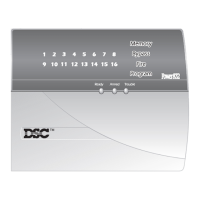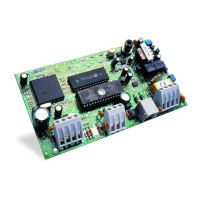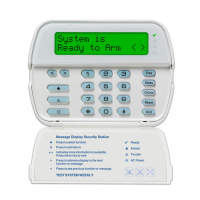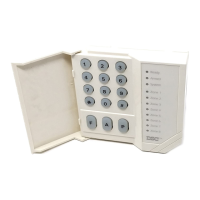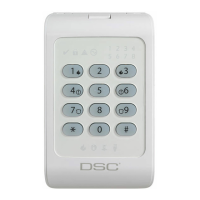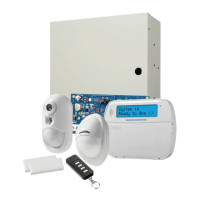K E Y P A D C O M M A N D S
18
“Exit” - Activate Quick Exit
Pressing this key will cause the panel to activate the Quick Exit feature (see Section 3.4
“[
✱
] Commands, [
✱
][0]”).
3.5.1 Function Key Options
The following is a list of function key options:
[00] - Null Key
The key is not used and will perform no function when pressed.
[01] - Select Partition 1
Provides an easy way to select partition 1 operation from a partition 2 keypad. This is the same as pressing and
holding the [#] key then pressing and holding the [1] key to select partition 1 from a partition 2 keypad (see Section
3.6
“Global and Partition Keypad Operation”
).
[02] - Select Partition 2
Provides an easy way to select partition 2 operation from a partition 1 keypad. This is the same as pressing and
holding the [#] key then pressing and holding the [2] key to select partition 2 from a partition 1 keypad (see Section
3.6
“Global and Partition Keypad Operation”
).
[03] - Stay Arm
Same as described in Function Keys - Section 3.5.
[04] - Away Arm
Same as described in Function Keys - Section 3.5.
[05] - [✱]+[9] No-Entry Delay Arm
After this function key is pressed the user must enter a valid access code. The partition will arm and remove entry
delay from the partition when the exit delay expires (see Section 3.4
“[
✱
] Commands, [
✱
] [9] Arming without entry
delay”
).
[06] - [✱]+[4] Door Chime On/Off
This function key provides the user a simple method for turning the Door Chime feature on and off (see Section 3.4
“[
✱
] Commands, [
✱
] [4] Door Chime on/off”
).
[07] - [✱]+[6]...[4] System Test
This function key provides the user with a simple method for testing the system (See Section 3.4
“[
✱
] Commands,
[
✱
] [6] User functions”
). A valid Master Code is required to perform this command.
[08] - [✱]+[1] Bypass Mode
This function key provides the user with a simple method for entering the Bypass mode. If an access code is required it
must be entered before bypassing can be performed (see Section 3.4
“[
✱
] Commands, [
✱
] [1] Zone Bypass”
).
[09] - [✱]+[2] Trouble Display
This function key provides the user with a simple method for entering the Trouble Display mode (see Section 3.4
“[
✱
]
Commands, [
✱
]+[2] Trouble display”
).
[10] - [✱]+[3] Alarm Memory
This function key provides the user with a simple method for entering the Alarm Memory Display mode (see Section
3.4
“[
✱
] Commands, [
✱
] [3] Alarm memory”
).
[11] - [✱]+[5] Programming Access Codes
This function key provides the user with a simple method for programming access codes. After this key is pressed
a valid system master or partition master code will have to be entered before the panel will allow programming to be
performed (see Section 3.4
“[
✱
] Commands, [
✱
] [5] Programming Access Codes”
).
[12] - [✱]+[6] User Functions
This function key provides the user with a simple method for programming User Functions. After this key is pressed
a valid system master or partition master code must be entered before the panel will allow user functions to be
performed (see Section 3.4
“[
✱
] Commands, [
✱
] [6] User functions”
).
[13] - [✱]+[7]+[1] Command Output Option 1
This function key provides the user with a simple method for activating a PGM Output programmed as Command
Output Option 1 (see Section 5.10
“PGM Outputs”
). By default, after this key is pressed a valid access code must
be entered (see Section 3.4
“[
✱
] Commands, [
✱
] [7] Command output functions”
).
[14] - [✱]+[7]+[2] Shock Sensor/Smoke Detector Reset
This function key provides the user with a simple method for activating a PGM output programmed as either option
[03] Sensor Reset or [20] Command Output option 2.
[15] - General Voice Prompt Help
This feature can only be programmed if both the Escort5580 and the PC5928/PC5936 audio matrix module are being
used.
When the function key is pressed, the intercoms will perform a Help page. The user must then press the Page/
Answer button on any intercom station to begin the help session with the Escort.
For more information, please refer to the PC5928
Installation Manual.
[16] - [✱]+[0] Quick Exit
Same as described in Function Keys - Section 3.5.
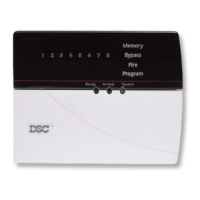
